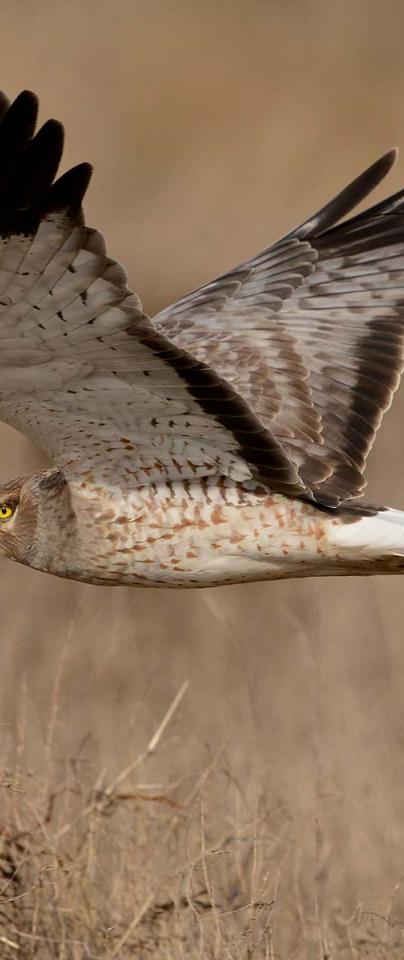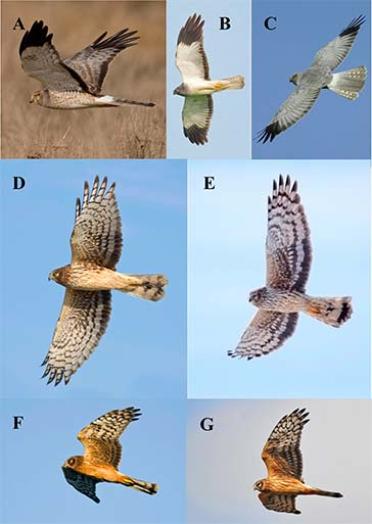The Circus of life: a tale of two Harriers
We speak to our conservation genomics expert Dr Graham Etherington on how the Hen Harrier is actually two species rather than one - correct classification will help save these endangered birds of prey.
Much of life on earth is under threat - and as top predators, birds of prey are among the most vulnerable. Hen harriers have been particularly persecuted, therefore it is of tremendous importance to understand their genomics within increasingly dwindling populations in order to aid conservation efforts such as the RSPB’s Hen Harrier LIFE project.
Led by Dr Graham Etherington, now of the Di Palma Group at Earlham Institute, a recent study into the phylogenetic relationship between two forms of Circus cyaneus, the European Hen Harrier (C. c. cyaneus) and the American Northern Harrier (C. c. hudsonius) has confirmed that these should really be classified as distinct species in their own right.
Until recently there were 13 breeding pairs of Hen harrier thriving in Lancashire’s Trough of Bowland, yet they have since disappeared.
Overlapping with areas used frequently for grouse shooting, these medium-sized raptors, along with other important birds of prey such as the Goshawk, have been persistently persecuted - resulting in their near-disappearance from the English countryside.
In order to help conserve such threatened species, it is important that we properly understand their genetic makeup in order that we can confidently map populations in specific regions.
When it comes to Circus cyaneus, it has long been accepted that there are two main forms, yet different organisations have come to different conclusions as to the status of these birds.
Recently, the British Ornithologist’s Union, have agreed that - in fact - the Hen harrier and its close relative the Northern Harrier are indeed distinct enough to be split, genetically and morphologically speaking. However, this is not the case for the American Ornithologist’s Union, who, along with other committees, have not yet enacted this change in classification.
However, if these birds are, in fact, two distinct species, then it is important to distinguish them as such - especially, if this means that their populations are thus diminished with respect to their current classification as a whole.
Thus, molecular phylogenetics was applied to the Hen harriers and the Northern harriers to see if genetics could shed some light on whether the accepted morphological nuances between the species indeed represent a genuine distinction. Using tissue samples provided by museums around the world*, comparisons were made between the two different forms of Circus cyaneus.
Three gene sequences were compared between Hen harriers and Northern harriers, while another closely related raptor - the Western marsh harrier (Circus aeruginosus) - was used as an outgroup.
Comparison of all three genes - Cytochrome b, Cytochrome Oxidase subunit 1 and NADH dehydrogenase 1 - all led to the same conclusion. Hen harriers and Northern harriers did indeed cluster into two distinct groups - with particularly high confidence for the NADH dehydrogenase gene.

Northern Hen Harrier by Simon Richards.
Before the days of genome sequencing, taxonomic classifications - though rigorous - were based on shared morphological characteristics.
However, sometimes it’s not incredibly obvious what constitutes similarity or relatedness on a morphological scale. A good example is the long dispute between primate scientists on whether humans are more related to orangutans or to chimpanzees and gorillas.
For a long time people had supposed that, based on certain characteristics, this might not be the case. Orangutans and humans, for example, both lack a bony appendage on the bottom, present in chimpanzees and gorillas.
There are a number of other similarities that has led some researchers to conclude that orangutans and humans are more related, yet this seems unlikely when we consider the overwhelming weight of molecular evidence that humans and chimpanzees diverged most recently compared to the other great apes.
With birds, these differences can be even more subtle. Ask a seasoned birdwatcher to explain to you the difference between certain varieties of bird and they’ll convincingly describe to you certain features that are obvious to a very well-trained eye - but to the layperson these are never entirely obvious.
They’re not even always that obvious using a powerful pair of binoculars.
The beauty of comparing DNA sequences, however, is that we know - based on the analysis of an ever-greater number of species - that they do tend to evolve at variably fixed rates over time; therefore we can, always with differing degrees of confidence, get a more precise estimate of when certain species have diverged.
Thus, molecular phylogenetics was applied to the Hen harriers and the Northern harriers to see if genetics could shed some light on whether the accepted morphological nuances between the species indeed represent a genuine distinction. Using tissue samples provided by The Burke Museum (University of Washington), the Museum of SW Biology (University of New Mexico), Museum of Natural Sciences (Louisiana State University), the Swedish Museum of Natural History and the University of Copenhagen Zoological Museum, and museum skins at the Museum of Vertebrate Zoology (UC Berkeley), the American Museum of Natural History, New York, The Philadelphia Academy of Natural Sciences and the Natural History Museum, Tring, comparisons were made between the two different forms of Circus cyaneus.
Three gene sequences were compared between Hen harriers and Northern harriers, while another closely related raptor - the Western marsh harrier - was used as an outgroup.
An outgroup is important when performing phylogenetic analysis. It makes logical sense that we can better compare more closely related species (i.e. Hen harriers and Northern harriers) when compared to a slightly more distant relative.
Comparison of all three genes - Cytochrome b, Cytochrome Oxidase subunit 1 and NADH dehydrogenase 1 - all led to the same conclusion. Hen harriers and Northern harriers did indeed cluster into two distinct groups - with particularly high confidence for the NADH dehydrogenase gene.

These genetic indicators, for many ornithologists, add weight to what is already known about the differences between the two birds. And, when looking for differences between the species, as is common with birds, the adult males show much of the specific patterning that can help us to properly distinguish them apart.
The paper notes that adult male C. hudsonius are different from C. cyaneus in a number of ways. They are much darker and more streaked, with a characteristic dark ‘saddle’ across the back and darker wing coverts (the smaller base feathers of the wing), while they also show more variation in the streakiness of their bodies and under-wing.
For sub-adult males, there are also differences between the two species, especially when looking at plumage. Notably, the tail markings give this away; with sub-adult C. hudsonius showing up to seven thick tail bars that extend the whole width of the feather, compared to C. cyaneus individuals that only have a subtly complete terminal tail bar, while the other feathers show barring restricted mainly to the inner webs of the feathers.
Females differ from each other by having slightly different markings on the underparts, whilst juvenile Northern Harriers differ from its counterpart by having rich chestnut-orange underparts and a dark back and ‘hood’.
It’s hard to imagine this without pictures, so thankfully the paper provides some images that we hope will shed some light on these somewhat subtle differences.